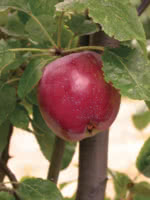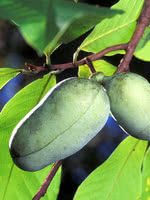Mon-Fri 9am - 5pm Mountain time
September Ruby Apple vs Pawpaw
Malus x September Ruby
Asimina triloba
September Ruby is a very cold hardy tree developed for the Prairie Fruit Breeding Cooperative. It is a vigorous grower that is resistant to fire blight and is popular among orchards for its annual production. Its apples are very good for eating and cooking. This tree blooms in mid May for an attractive ornamental.
For fruit production, cross-pollination is required. Apples need to be planted with another Apple or Crab Apple variety.
Note: We do not ship grafted apples to BC due to regulatory restrictions from the Canadian Food Inspection Agency.
The Pawpaw tree produces delicious, sweet fruit with a unique banana-mango flavor. These oblong fruits start yellowish-green and mature to a dark brown in the fall. It is best to leave them on the tree until ripe, as they do not ripen well once picked. Pawpaws can be enjoyed fresh, in baking, or in ice cream.
Pawpaws produce the largest native fruit in North America. They typically grow as a small understory tree or large shrub on wooded slopes, in ravines, and along stream banks. They often spread through root suckers, forming dense thickets over time.
For fruit production to occur more than one genetically different Pawpaw tree is required. Our Pawpaw seedlings are grown from seed so they are all genetically different.
Note: Avoid eating the seeds and skin of the Pawpaw fruit as they can cause stomach pain for some individuals. Contact with the skin of the fruit can also result in skin irritation, so it is recommended to wear gloves during harvest. Plant this tree once. Due to its large tap root transplanting is not recommended.

